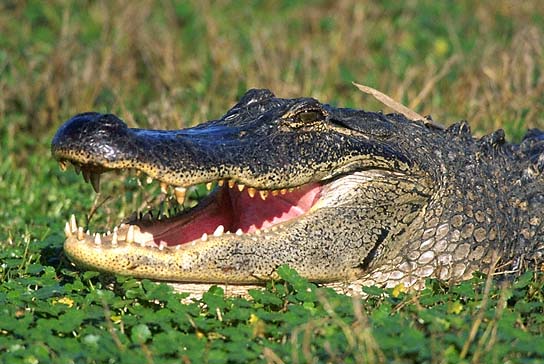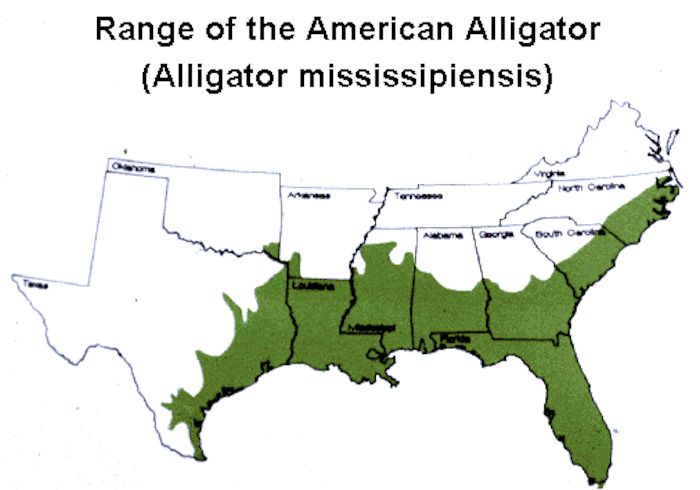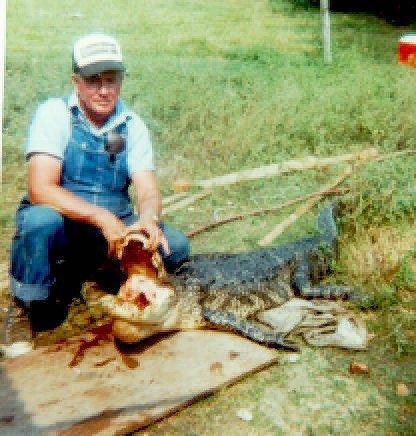Crocodiles and Alligators
 |
American Alligator
Alligator
mississippiensis |
Description
6'-19'2" (1.8-5.84 m). Largest
reptile in North America. Distinguished from American Crocodile by
broad and rounded snout. Generally black with yellowish or cream
crossbands that become less apparent with age. Large 4th tooth on
bottom jaw fits into a socket in upper jaw, is not visible when
mouth is closed. No curved bony ridge in front of eyes, as seen in
Spectacled Caiman.

Warning
Alligators are carnivores that feed on
fish and other large water animals and also stalk prey onshore near
water. All alligators should be considered dangerous, even those
basking in the sun. They can attack with amazing suddenness and have
very sharp, grasping teeth and powerfully strong jaws.
Voice
During the breeding season adults produce a
throaty, bellowing roar heard over considerable distance. Young give
a high-pitched call: y-eonk, y-eonk, y-eonk.
BreedingMates April to May after emerging from
hibernation. In June, female builds a mound-shaped nest about 5-7'
(1.5-2.1 m) in diameter and 1 1/2-3' (46-91 cm) high, of mud,
leaves, and rotting organic material; deposits about 25-60
hard-shelled eggs, 3" (76 mm) long, in cavity scooped from remains
near nest. The calling of hatching young prompts the female to
scratch open the nest to free them. Hatchlings are 9-10" (22.8-25.4
cm) long and remain with the female for 1-3 years. |
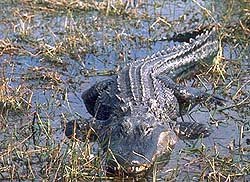 |
Habitat
Fresh and brackish marshes, ponds, lakes,
rivers, swamps, bayous, and big spring runs.
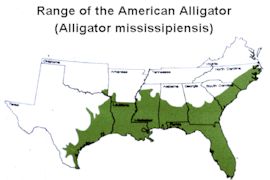 |
RangeThe indigenous range of A. mississippiensis is from coastal North Carolina south to southern Florida and the Keys, and westward through the Deep South to central Texas and extreme
southeastern Oklahoma. American alligators may eventually be found in Mexico in localities adjacent to the Texas border. |
DiscussionAlligators are important to the
ecology of their habitat. During droughts they dig deep holes, or
"dens," which provide water for the wildlife community. They
hibernate in dens during the winter. Diet consists of rough fishes,
small mammals, birds, turtles, snakes, frogs, and invertebrates.
Alligators have been relentlessly hunted for their hides and were
much reduced in numbers. Under state and federal protection,
their numbers have increased significantly and hunting seasons are allowed
in several states. Louisiana is one state with a legal hunting season and
large alligators are harvested as shown in the photo on the right (14 ft. gator) where my father Van W. Walker, shown with the gator, helped my Uncle Billy Whatley to keep the population in check. |
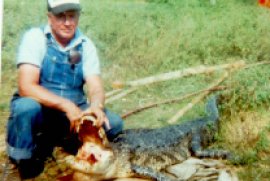 |





